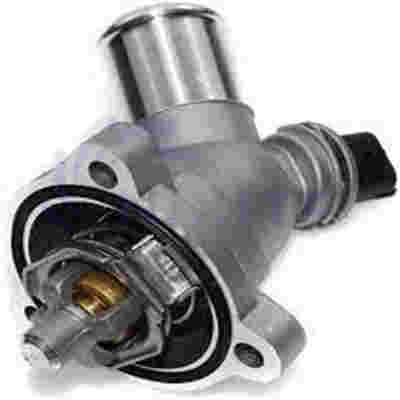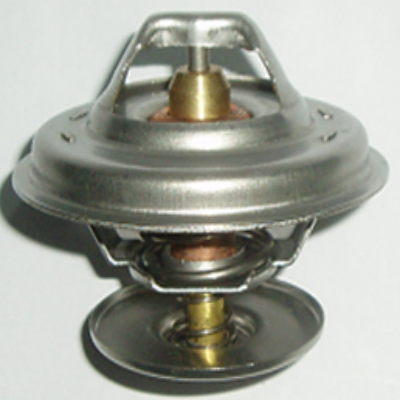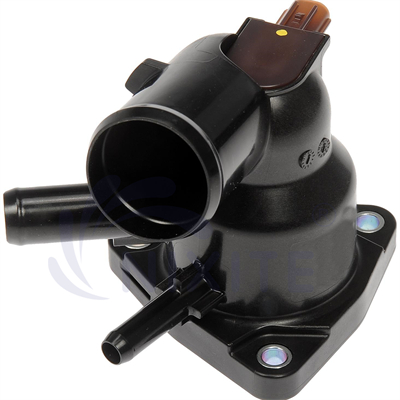If the water temperature of the car engine is too high, the engine temperature will be too high, which will cause the engine to overheat and cause the engine to lose its normal working ability. Generally, when the engine is overheated, it will be accompanied by serious shaking, insufficient power and weak acceleration when the car is driving, which are all caused by the overheating of the engine. So, how do you prevent your engine from overheating? The thermostat plays a big role! How does it work when it’s burning against the stove? What does the thermostat do?

1) When the engine water temperature reaches 100°C, the temperature control valve is closed, the cooling water circulation stops, and the engine temperature is lowered. At the same time, due to poor heat dissipation, the engine will generate high temperature.
When the temperature drops to a certain level, the cooling water valve controlled by the thermostat will open. At this time, the water is circulating, and when the temperature of the cooling water decreases, the water flow rate in the engine cooling system will slow down, thereby reducing the operating temperature of the engine. At the same time, since the water in the cooling system flows into the crankcase, the temperature of the cooling water will drop, which will make the engine oil thicker, causing the engine oil pressure to increase, resulting in high temperature.
When the engine temperature drops to a certain level, the thermostat controls the cooling water valve to open, so that the water in the engine cooling system flows, and the water in the cooling system circulates into the crankcase again. During this cycle, the heat generated in the cooling system is difficult to transfer to the engine block and crankcase surface. And the engine works in a high-temperature environment, and the cooling system of the engine will have poor heat dissipation.

- During the use of the engine, keep the cooling water circulating smoothly. If the cooling water temperature is too low, you should immediately open the radiator cover to prevent the radiator from being soaked in water. At the same time, the engine should be cleaned frequently to prevent cooling. The formation of scale, thereby reducing the heat dissipation capacity When the engine water temperature is higher than 95 ° C, the radiator cover should be opened to drain the cooling water in the water tank, so as to avoid the uneven cooling of the cooling water and the expansion of hot water to cause damage to the engine. When the temperature is lower than 95°C, the radiator cover needs to be opened for cooling. At the same time, the intake system, water jacket, and cylinder liner should be checked frequently for damage during use. The cooling system of the engine is designed in a closed circulation pipe to prevent the hot and cold unevenness caused by the mutual flow of cold and hot water. Among them, the water tank, cylinder head and cooling water are composed of three parts, which undertake the task of engine temperature control. In the heat dissipation process of the engine, the cooling water is circulated through the evaporative cooling method, so when the engine temperature is too low, the radiator cover needs to be opened for cooling. At the same time, it is necessary to ensure that there will be no scale in the radiator, and the water tank will not expand too much to cause uneven water circulation.
- Regularly check the radiator and oil pan oil level. The radiator has two parts, one is a water-cooled radiator and the other is an air-cooled radiator. Water-cooled radiators have relatively poor heat dissipation capabilities and cannot solve heat problems well. One of the main reasons for poor heat dissipation effects is that the engine oil has deteriorated and stinks after being used for too long. So it is very important to check the oil level of radiator and oil pan regularly, especially in high temperature environment. In order to ensure the normal operation of the engine, the phenomenon of excessive water temperature caused by poor water circulation can be eliminated in time. For water-cooled radiators that have been used for a long time, they should be checked and analyzed regularly. At the same time, the oil filter element should be replaced in time according to the temperature.
- Place a thermostat near the oil pan cover. The function of the thermostat is to close the temperature control valve of the engine when the water temperature reaches 100°C, so as to stop the water circulation in the engine cooling system and reduce the pressure of the engine oil pump. Lubrication. This one is not as simple as in other cases. In addition, if the water temperature reaches 80°C, the thermostat does not work and the engine is in a high temperature state, which will cause the engine temperature to rise sharply. Therefore, we must regularly check whether the thermostat needs to be overhauled or replaced. If maintenance or replacement is required, it must be carried out by a regular manufacturer. When choosing a thermostat, it is necessary to choose some products that have been inspected and have no fault proof marks. At the same time, pay attention to check whether it is damaged. Whether there is air leakage. Is there any debris blocking the thermostat joint? Whether there are other faults such as bearing burnout and other adverse phenomena.
- Avoid heating the car or close the cooling water outlet immediately after starting.
After parking, the cooling water port should be closed, do not close the cooling water port immediately. Because when the temperature in the cooling chamber rises after starting the car, the engine oil will produce a large amount of viscous oil mist. These viscous oil mist particles will cause frictional resistance and high temperature to parts such as pistons and cylinder liners. At this time, if the cooling water outlet is closed immediately, the water temperature will quickly rise to the highest value of about -70°C. Therefore, it is necessary to close the cooling water port after starting the car, and then close it after the water temperature rises to the highest value. In addition, if the cooling water outlet is closed immediately after the car is warmed up, the cooling effect will also be affected, and even the exhaust will not be smooth. Therefore, the correct way is to close the oil outlet after starting with the hot gear, and then open the oil outlet after the water temperature rises to idle speed or start the computer to run at idle speed.
2) When the water temperature reaches 100°C, the temperature control valve opens, the cooling water circulation stops, and the water temperature drops. At this time, there is a large amount of air in the cooling water circulation pipeline. The water boils, thus raising the temperature of the tank water.

At this time, more scale appears in the water tank, and the flow rate of cooling water will decrease. Because the scale will take away the heat of the engine. The cooling system will overheat, causing the engine temperature to rise. At this time, the thermostat will open, and a large amount of air will enter the condenser in the cooling pipeline, and the water temperature will reach the upper limit when the condenser is working. At this time, the engine will be overheated, and the engine vibration will seriously fail to reach the standard operating temperature, causing the engine to be overhauled.
- If the engine is overheated, immediately check whether the water pump in the cooling system is leaking and whether the thermostat is turned on.
The coolant flows out of the cooling water jacket, and it should be placed at the place where the coolant overflows for a few minutes to make it flow out. If the temperature of the water coming out of the condenser is too high, there may be a problem with the cooling system. If there is no problem with the cooling system, the water pump in the cooling system should be overhauled immediately to eliminate the fault. At the same time, clean the dust and sundries on the thermostat and the pipeline interface to make it reach the standard operating temperature. Repair and replace the water pump. If the water pump leaks, it must be repaired immediately, and do not wait for the cooling system to leak before repairing it. Otherwise, not only the maintenance effect cannot be achieved, but its damage will be accelerated. - If the coolant temperature is too high, there should be a lot of cooling water flowing in the cooling water circulation pipeline.
However, if the cooling water contains a large amount of sundries, it will cause blockage of the cooling water circulation pipeline, thereby affecting the cooling effect. At this time, the thermostat should be closed. So as to achieve the antifreeze effect. Because the thermostat will automatically open to stop the water cooling system from working. But it should be noted that the thermostat must be turned off! - What should I do if I encounter overheating?
Check the temperature of the water tank: Check whether there is a cooling water leak in the cooling system and deal with the leak point. Use the cooling water circulation pump: Note that if the cooling water temperature is too high during engine operation, the engine can be run at idle speed to reduce the pressure loss caused by the rising cooling water temperature to the engine. Stop immediately and take measures to reduce the cooling water temperature. Cooling water pump: Note that if a large amount of air enters the condenser in the cooling water circulation pipeline, all water tank drain valves should be closed immediately to allow the cooling water to circulate and reduce the pressure loss in the cooling water circulation pipeline. Replace the cooling water: If the water temperature is too high, you should use a special water pump to change the water or increase the circulation pipeline to control the water temperature to drop to the normal temperature. If the water temperature is as low as 150°C, a special water pump should be used to cool down the car cooling system. Use water treatment system: You should try to use low temperature tap water or clean water without scale to treat the car cooling system, so as to reduce the high temperature hot car phenomenon caused by the scale remaining on the surface of the radiator and improve the heat dissipation efficiency. - What matters need attention?
Do not change the indication of the water temperature gauge arbitrarily: after checking whether the cooling system is working normally and adjusting to the proper working temperature every few days, it can be found on the engine oil filter. Pay attention to replace the cooling water: check whether the amount of cooling water added is sufficient every once in a while to prevent damage to the water tank and air in the condenser. Controlling the cooling water temperature: If the thermostatic valve is kept closed, there should be a lot of air in the cooling water circuit entering the condenser and water pipes. If the cooling system cannot work normally and the temperature is lower than the minimum working temperature, the valve of the cooling system should be opened to control the cooling water temperature to drop. Do not open the water tank cover at will: After the vehicle has been used for a long time, a large amount of scale will be generated inside the water tank. Although these scales are not harmful to the engine oil, the combination of water and engine oil will form a layer of colloidal film that hinders the absorption of oil nutrients and affects the oil. lubricating effect. Therefore, it is recommended that car owners should clean it regularly.
3) Under normal operating temperature, the engine cooling water circulation can keep the engine oil working at an appropriate speed.
But if the cooling water temperature is too high, it will affect the heat dissipation of the engine. Because when the cooling water circulates, the water temperature is higher, which will make the engine temperature rise sharply. At this time, the engine oil condenses due to high temperature, which can easily make the oil flow poor and cause the engine to heat up. Therefore, the thermostat in the cooling water circulation system should be adjusted in time to avoid overheating. The thermostat is generally on the radiator, but also inside the engine cover or on the water tank. It is mainly used to maintain a certain volume of cooling water circulation when the water temperature reaches a certain temperature, so as to improve the heat dissipation effect between engine parts. Therefore, it is necessary to check frequently whether the thermostat is damaged or malfunctioning, and it must be repaired and replaced in time.
- The thermostat is a device that uses the temperature difference of the cooling water itself to adjust the water temperature, so the engine cooling water circulation thermostat of the car must work according to a certain working principle.
First of all, the working principle of the thermostat is: the water in the water tank overflows from the opening on the water-cooled thermostat. A new circulation then flows from the coolant tank. When the amount of cold water in the water tank decreases, the engine water-cooled engine with increased water amount will heat the water. As the water temperature increases, the water temperature in the circulation will gradually increase. Then the heat in the coolant flowing out of the opening of the thermostat and the water temperature will quickly equalize, so that the water temperature is always maintained at a fixed value. When the water temperature rises to a certain temperature, the thermostat will not be closed immediately because there is no water leakage from each valve. However, if the thermostat is not closed tightly, the amount of hot water will continue to increase, and when it exceeds the water temperature, the viscosity of the lubricating oil will decrease, resulting in poor lubrication and increased wear of the machine parts. - If the water temperature after general cooling water circulation is too high, you should replace it with new water in time to reduce the water temperature. If it is too low, you should immediately add new water or add a suitable coolant to increase the water temperature. In low temperature or severe cold areas, before starting the engine in winter, check the water supply system and air intake system for leaks. Check whether the water temperature gauge, thermostat, water tank, etc. are normal. If the thermostat is found to be damaged, it is necessary to repair it in time or replace it with new cooling water to reduce the water temperature. If the water temperature rises suddenly or reaches a critical temperature, it is necessary to add new water before continuing to work or stopping for a rest. If the water temperature continues to be about 4°C higher than the normal working temperature, stop the machine immediately and add water to cool it down. If the coolant is too thick, you should add new water or add a suitable coolant in time to improve its quality. At the same time, pay attention to check whether the thermostat and radiator are operating normally.
- In general, replacing the thermostat can solve these problems:
a. Engine overheating: due to incomplete heat dissipation, the high temperature of the water generates a lot of heat, which makes the water pump unable to work normally. At this time, the thermostat should be replaced.
b. Cylinder or cylinder head overheating: cylinder head plate and cylinder pad overheating cause deformation of the cylinder block.
c. The water temperature is too high: the water temperature rises suddenly. Normally the thermostat can be replaced.
d. The cooling water temperature drops: when the water temperature drops too fast, the flow rate of the water pump can be increased.
